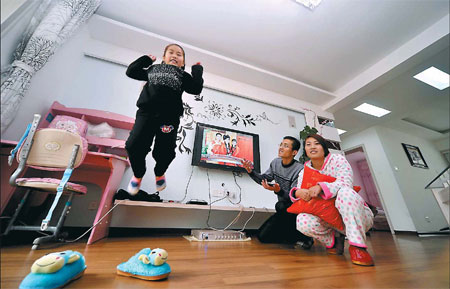|
 |
|
The daughter of coal miner Liu Yubao and his wife jumps happily in their new home in the Suihe Huayuan residential community in Huaibei city, East China's Anhui province, earlier this year. More than 3,000 coal miners with the local Huaibei Mining Group, such as Liu, moved into the newly built community for miners and their families, who had previously lived in run-down shacks. [Photo/China Daily]
|
10m units started this year for low-, middle-income residents of cities
BEIJING - China launched an unprecedented push for large-scale construction of affordable housing this year in a major effort to meet the living needs of city dwellers amid rocketing property prices and high rents.
By the end of October, construction had already begun on more than 10 million affordable-housing units, meeting the goal the government set for this year, according to the Ministry of Housing and Urban-Rural Development.
The target far exceeded the government's goal of building 5.9 million such houses in 2010.
The affordable-housing program includes government-subsidized, low-rent housing for low-income residents, public rental and limited-price homes for middle-income earners who cannot afford to buy on the commercial market, and the renovation of run-down urban properties.
China started selling housing on the commercial market in 1998, a move made in concert with plans to provide affordable housing to low-income city residents, who in recent years have suffered from soaring property prices.
The affordable-housing program has now become a top concern among senior Chinese officials because access to housing is considered an important part of the country's social welfare.
By October, the central government had invested 152.2 billion yuan ($24 billion) in affordable housing, according to the latest official figures.
Land supply for the construction of such houses nationwide is expected to reach 77,400 hectares this year, nearly 140 percent more than last year, according to the Ministry of Land and Resources.
In November, Vice-Premier Li Keqiang said China must continue to push the construction of affordable housing forward next year, and he emphasized that quality of construction must be maintained.
Li made the comments while inspecting an affordable-housing construction site in Langfang, in North China's Hebei province.
He also said that with the completion of more affordable housing, a fair method of allocating homes is necessary to guarantee that government's efforts benefit people in need.
In December, migrants, who do not have Beijing hukou - permanent residence permits - lost hope of being able to get public rental housing because they have to wait for more detailed eligibility criteria to be worked out for latest policy released by the Beijing municipal government.
The eligibility details for migrants will vary by district, depending on the applicant's situation and the number of candidates and public rental units available in the district.
So far, no districts have released detailed guidelines.
By contrast, Jiang Weixin, minister of housing and urban-rural development confirmed in October that some residents of affordable-housing units drive luxury cars, such as BMWs, which shows that there are loopholes in the program's management.
Analysts urged government authorities to speed up the establishment of a national information system covering personal-housing assets to lay the foundation for fair and open distribution of subsidized housing.
"Local authorities should investigate more deeply applicants' eligibility to live in such units, and stricter penalties are needed if residents are found ineligible for their affordable housing," said Liu Yuan, a senior analyst with China Centaline Property Research in Shanghai.
"In the US and Hong Kong, residents of such units have to pay a higher rent, even the same as renting a commercial house, if they remain in the home after their annual income grows to exceed the limit," he said.
"We should learn from such experience in the management of affordable housing," he said.
The total number of new housing units for low-income families and run-down houses to be renovated will reach 36 million from 2011 to 2015, official figures showed.
When completed, the program is expected to cover 20 percent of the country's total housing supply.

|